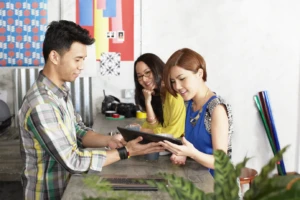
Mobile Technology and the Modernization of In-store Sales
The traditional brick-and-mortar business model has changed. On-site retailers can now more effectively compete with their online cousins. Tools that were once the sole purview of online retailers are now up for grabs, and forward-thinking traditional businesses and customers alike are already reaping the rewards. One of the major technologies leading this in-store sales revolution: mobile.
As fate would have it, it was mobile technology that once helped derail on-site sales. Mobile access to online reviews and price comparisons gave customers new levels of product knowledge and it was only a small step from reviews and price compare to clicking on the ‘buy’ button that often left even the most informed in-store sales associates in the dust. In the modern store, employees are armed with the same mobile technology as their customers, making the breadth of product insight available on the Internet the starting point for in-store conversations.
Of course, being on equal footing with customers is just the beginning. To regain their place as trusted advisors, many brick-and-mortar businesses are embracing more advanced mobile solutions. Here’s how they’re making it happen.
Going beyond simple reviews and recommendations. The bias of online reviews can often be suspect, and customers know it. By adding company data and market insights to the sales conversation, associates can help customers separate fact from fiction. Some retailers are also using advanced tools to analyze the data they already have, and using the results to make product recommendations that factor in transaction history and customer knowledge, as well as outside influences such as weather, events, and holidays.
Streamlining the buying process. Once they decide to buy, customers simply want to pay and get on with their day. By adopting mobile point-of-sale (POS) tools, businesses reduce both the hassle and the labor involved in getting happy customers out the door. These quicker sales can also be made from the product floor, where items not in stock can be purchased with the option of immediate pickup at neighboring store locations or home delivery.
Reinventing loyalty programs. The rewards card is due for an update, and it’s coming in the form of an app. Not only will apps reduce the amount of plastic and coupons populating customer wallets, they’ll expand the ways businesses can interact with their communities. By using apps in-store, customers can discover location-specific specials and deals.
For business owners, these apps have even more significance. Customer clicks and hovers can be collected as they navigate a store’s app in conjunction with their store visit, and that data can be added to their profiles, allowing brick-and-mortar stores the same insight into their customers’ habits that online retailers enjoy.
Personalizing the customer experience. Mobile isn’t alone in helping traditional businesses modernize. Equally important in leveling the online vs. on-site playing field is the suite of cloud-based machine learning and analytics tools that’s been developed in the last few years.
By unifying customer knowledge gathered from social media, sales, and in-app activity, these tools give businesses a more complete picture of each individual that walks through the door. Trends as specific as which customers purchase scarves on rainy days can be tracked and acted upon, so offers can be tailored to each customer’s tastes. Exclusive, customer-specific specials can also be delivered in time to inform customers as they shop.
With all of these new capabilities at their disposal, the biggest hurdle facing brick-and-mortar businesses as they continue to modernize is the customer expectation of things to simply work. Piecemeal solutions may offer much of the functionality mentioned in this article, but unless the end result is a seamless, holistic customer experience, businesses run the risk of being perceived as out of touch with today’s cloud-first, mobile-first shoppers.
If you want to brush up on customer expectations, check out our retail fact sheet. You can also explore some of the modern solutions that exist for traditional businesses here, or take a look at the solutions Microsoft has to offer NRF 2016.

